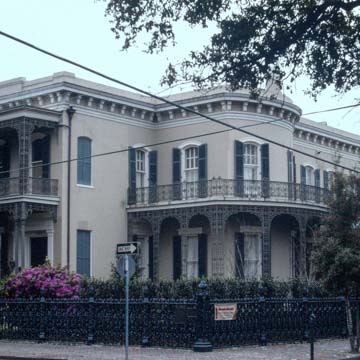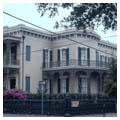Although it is justifiably famous for its cast-iron fence (one of three nineteenth-century cornstalk fences in the city; see OR22), the house itself is equally splendid. The fence, patterned in morning glory vines and cornstalks, was manufactured in New Orleans by Wood, Miltenberger and Company. Henry Howard designed the Italianate house for Kentuckian Robert Short, a cotton commission merchant, at the same time as the Dufour-Baldwin House (OR65), and it shows the ease with which Howard could turn out magnificent stucco-covered brick houses with just enough individuality to please his clients. The house was constructed by Robert Huyghe, a builder from Baltimore. Emphasizing width as much as height, it has a suburban feel in contrast to the Dufour-Baldwin’s urbanity. Two-story galleries shade the front and the curved bay on the left side; a single-story gallery wraps around the larger side bay on the right. A heavy bracketed cornice and parapet conceal the flat roof. The entrance hall extends through the house to a cross hall at the rear of the double parlors, a feature Howard employed for other houses. The double parlors to the left of the hall are separated by two columns, forming a triple arch. Interior details for door casings, plaster cornices, and the entrance door are Greek Revival. The curved staircase toward the rear of the hall was added in the early twentieth century, when some interior changes were made; Koch and Wilson, Architects, also did some work on the house in the 1960s, including remodeling the loggia. Before the house was completed, the Civil War began. Colonel Short and his wife, Margaret, fled New Orleans for Kentucky but returned after the war and reclaimed the house. General Nathaniel Banks of the Union Army occupied it during the war, in 1864 and 1865. The original grounds were subdivided in 1950 for the construction of two houses.
You are here
Robert Short House
If SAH Archipedia has been useful to you, please consider supporting it.
SAH Archipedia tells the story of the United States through its buildings, landscapes, and cities. This freely available resource empowers the public with authoritative knowledge that deepens their understanding and appreciation of the built environment. But the Society of Architectural Historians, which created SAH Archipedia with University of Virginia Press, needs your support to maintain the high-caliber research, writing, photography, cartography, editing, design, and programming that make SAH Archipedia a trusted online resource available to all who value the history of place, heritage tourism, and learning.





